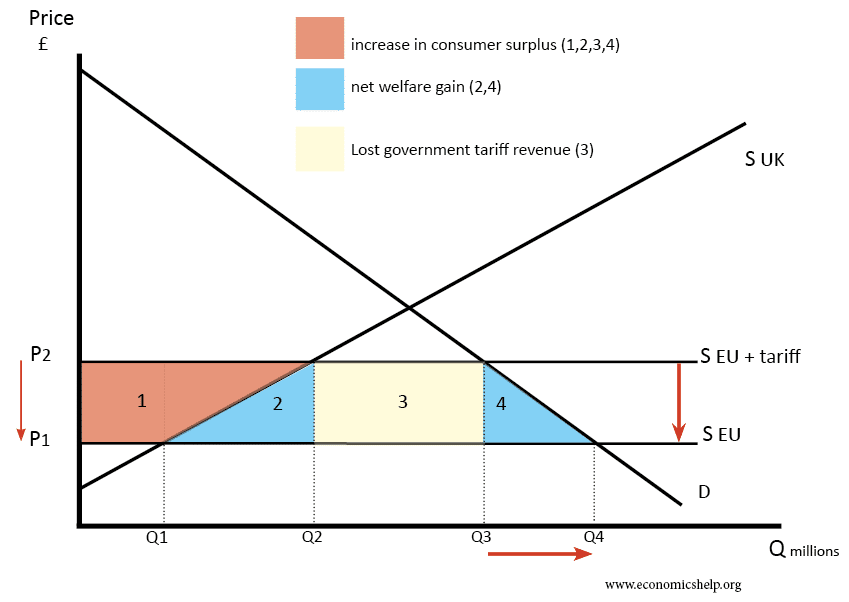Definition
Trade liberalisation involves removing barriers to trade between different countries and encouraging free trade. Trade liberalisation involves:
- Reducing tariffs
- Reducing/eliminating quotas
- Reducing non-tariff barriers.
Non-tariff barriers are factors that make trade difficult and expensive. For example, having specific regulations on making goods can give an unfair advantage to domestic producers. Harmonising environmental and safety legislation makes it easier for international trade.
Advantages of Trade Liberalisation
- Comparative advantage. Trade liberalisation allows countries to specialise in producing the goods and services where they have a comparative advantage (produce at lowest opportunity cost). This enables a net gain in economic welfare.

Trade liberalisation leads to removal of tariff barriers and the market price will fall from P2 to P1. This leads to significant increase in consumer surplus of areas 1+2+3+4. The net welfare gain is 2+4
- Lower prices. The removal of tariff barriers can lead to lower prices for consumers. E.g. removing food tariffs in West would help reduce the global price of agricultural commodities. This would be particularly a benefit for countries who are importers of food.
- Increased competition. Trade liberalisation means firms will face greater competition from abroad. This should act as a spur to increase efficiency and cut costs, or it may act as an incentive for an economy to shift resources into new industries where they can maintain a competitive advantage. For example, trade liberalisation has been a factor in encouraging the UK to concentrate less on manufacturing and more on the service sector.
- Economies of scale. Trade liberalisation enables greater specialisation. Economies concentrate on producing particular goods. This can enable big efficiency savings from economies of scale.
- Inward investment. If a country liberalises its trade, it will make the country more attractive for inward investment. For example, former Soviet countries who liberalise trade will attract foreign multinationals who can produce and sell closer to these new emerging markets. Inward investment leads to capital inflows but also helps the economy through diffusion of more technology, management techniques and knowledge.
- More advantages of free trade.
Problems of Trade Liberalisation
- Structural unemployment. Trade liberalisation often leads to a shift in the balance of an economy. Some industries grow, some decline. Therefore, there may often be structural unemployment from certain industries closing. Trade liberalisation can often be painful in the short run, as some industries and some workers suffer from the decline in uncompetitive firms. Though net economic welfare improves, it can be difficult to compensate those workers who lose out to international competition.
- Environmental costs. Trade liberalisation could lead to greater exploitation of the environment, e.g. greater production of raw materials, trading toxic waste to countries with lower environmental laws.
- Infant-industry argument. Trade liberalisation may be damaging for developing economies who cannot compete against free trade. The infant industry argument suggests that trade protection is justified to help developing economies diversify and develop new industries. Most economies had a period of trade protectionism. It is unfair to insist that developing economies cannot use some tariff protectionism. Because of this argument, some argue that trade liberalisation often benefits developed countries more than developing countries.
See: Arguments against free trade
Conclusion
Trade liberalisation can give substantial economic benefits. However, these benefits may not be distributed equally. Also, the success of trade liberalisation depends on how flexible an economy is. If workers are highly educated and flexible, then it is easier for an economy to switch the nature of production. But, if there are labour market inflexibilities, then structural unemployment may persist for quite a while.
The other issue for trade liberalisation is that it often benefits developed countries more than developing economies. There are strong reasons to allow some tariff protectionism if developing economies are seeking to diversify out of low-income growth agricultural industries.
One function of the WTO is to support trade liberalisation.
Related

what are the costs of trade liberalisation
trade liberation can result in structural unemployment.
why can it result in structural unemployment?
Please what are the factors of trade liberalisation?
Factors may include reduction of tariffs, quotas, embargo and trade barriers.
what are three way that caribbean government can support the goal of trade liberalization in the region
the ways the Caribbean government may support the development of a trade liberal policy in the region is through pursuing free trade agreements (FTAs) and removing protectionist barriers to the free flow of goods and services such as tariff and non-tariff based protection. Hopefully this helps, I’m also trying to complete an assignment on trade liberalisation.
Imagine you are the president of a small developing country. Would you follow trade liberalization as a strategy to increase development (you may discuss alternative approaches to achieve development if appropriate)? Could you explain your answer?
no
Yes, I will focus on Trade Liberalization as a a developmental strategy provided the benefits of TL (comparative advantage, lower prices, increased competition, economies of scale, inward investments, etc.) outweighs the problems of TL (structural unemployment, environment costs, problems of dumping, etc) and efforts will be more tailored into reducing or eliminating the problems of TL.
Which are the effect on consumer and producer surplus of the liberalization trade between two big countries?